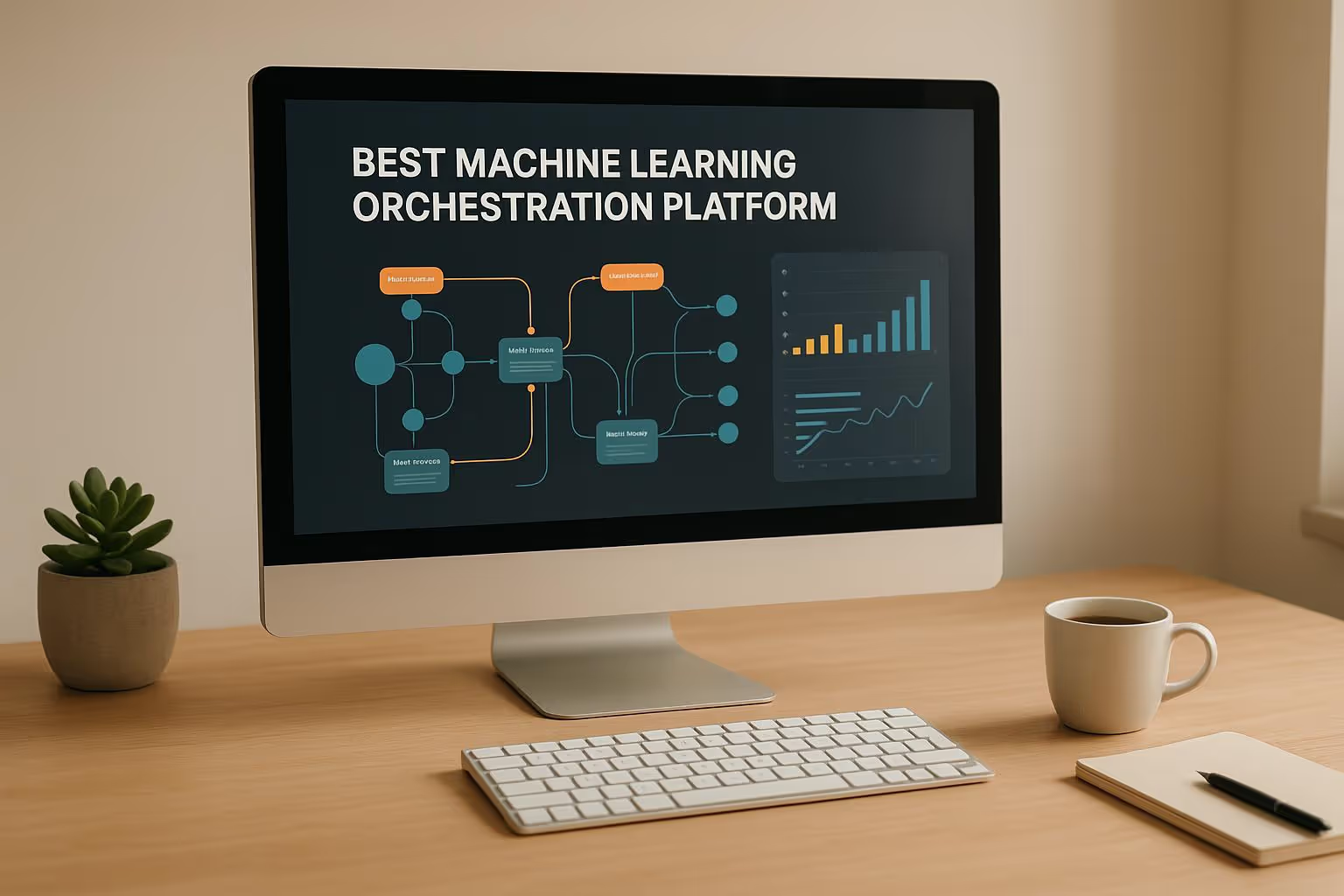
Machine learning orchestration platforms simplify AI workflows, reduce costs, and enhance scalability. This guide evaluates 10 leading platforms based on their features, usability, and cost transparency to help you choose the right solution for your business needs.
| Platform | Best For | Key Features | Limitations |
|---|---|---|---|
| Prompts.ai | LLM orchestration | Unified access to 35+ LLMs, cost savings | Limited for non-LLM workflows |
| Apache Airflow | Custom ML workflows | Flexible DAGs, multi-cloud support | Complex scaling |
| Kubeflow | Kubernetes users | Distributed training, scalability | Requires Kubernetes expertise |
| DataRobot | Automated ML | AutoML, governance tools | High cost |
| Flyte | Python-based workflows | Scalable, containerized ML workflows | Maturing ecosystem |
| Azure ML | Enterprise cloud environments | Seamless Azure integration | Vendor lock-in, pricing |
| Google Vertex AI | Google Cloud users | TPU support, automated pipelines | Vendor dependency |
| Tecton | Real-time feature engineering | Feature store, real-time serving | Narrow focus, higher cost |
Choose a platform based on your priorities: cost savings, scalability, or integration with existing tools. For LLM-heavy workflows, Prompts.ai leads the pack. For broader ML needs, Airflow or Kubeflow are strong open-source options. Cloud-based enterprises may prefer Azure ML or Vertex AI for seamless integration.
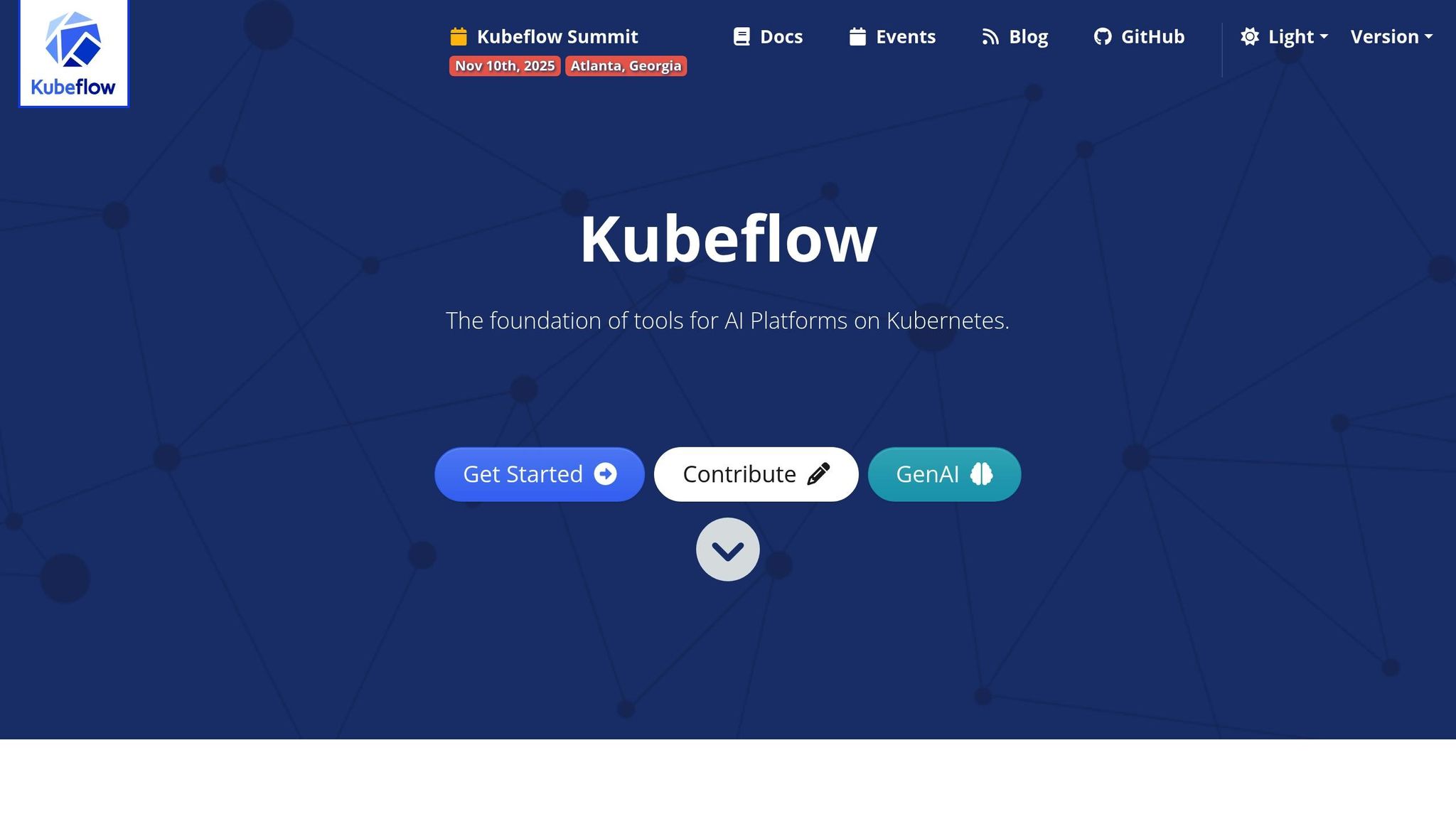
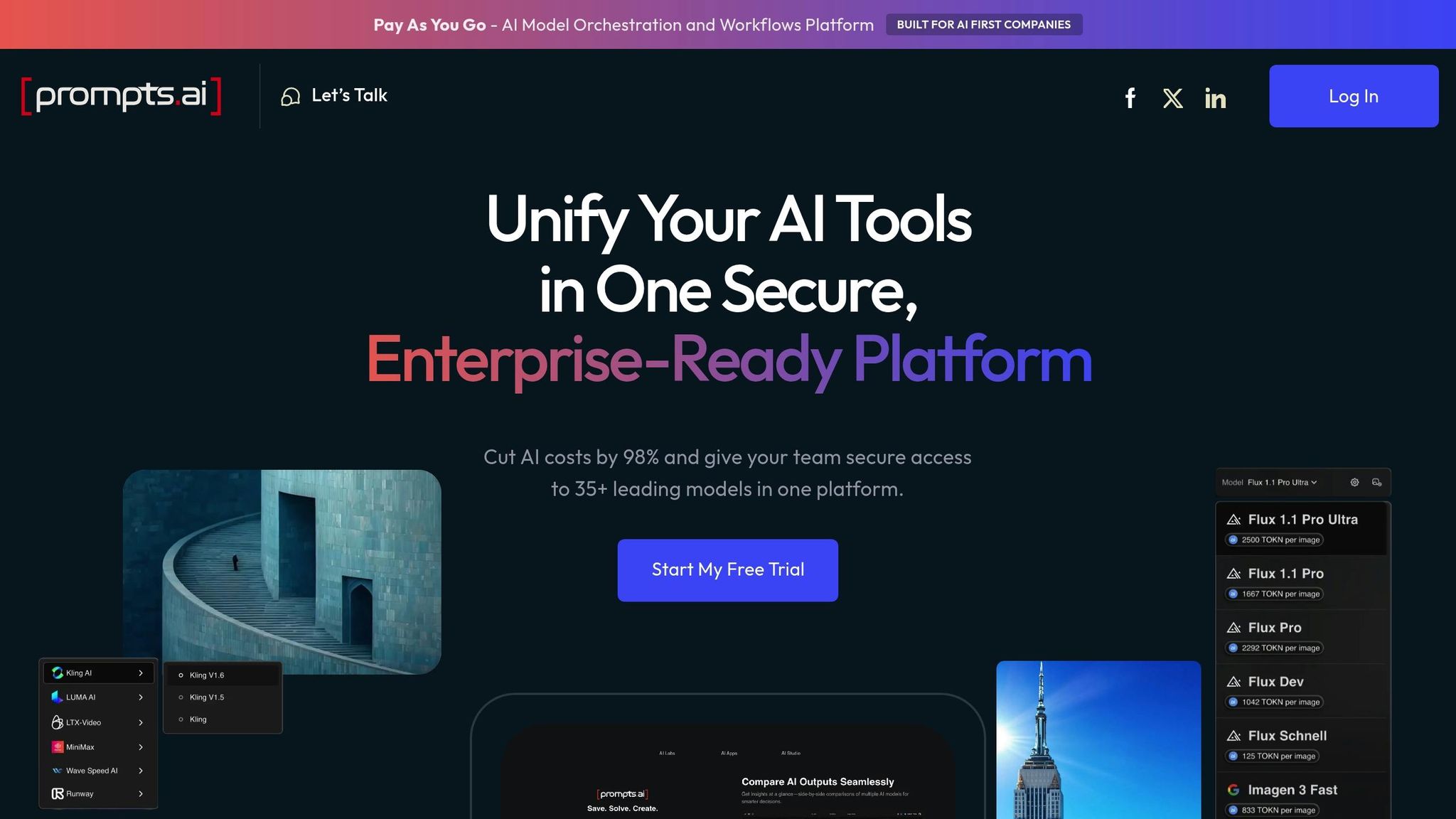
Prompts.ai is an enterprise-grade AI orchestration platform designed to simplify the management of AI tools. It tackles the challenges of tool sprawl and hidden expenses, which often hinder AI initiatives before they can deliver measurable results.
By focusing on interoperability, scalability, and efficient workflow management, Prompts.ai addresses critical pain points in enterprise AI operations.
The platform's standout feature is its ability to unify access to more than 35 leading large language models (LLMs) - including GPT-4, Claude, LLaMA, and Gemini - through a single, secure interface. This approach eliminates the fragmentation that typically complicates enterprise AI deployments.
Prompts.ai ensures seamless cross-model compatibility by offering a unified interface that works across various LLM providers. It also integrates with widely used business tools like Slack, Gmail, and Trello, making it a natural fit for existing workflows.
The platform's architecture supports side-by-side comparisons of different models, allowing users to evaluate performance without needing multiple interfaces or API keys. This streamlined approach simplifies decision-making and ensures the best model is chosen for each specific use case.
Designed to handle enterprise-level demands, Prompts.ai features a cloud-native architecture that can scale effortlessly as teams grow and AI usage increases. Adding new models, users, or teams is a quick and straightforward process, requiring no significant infrastructure changes.
The platform's pay-as-you-go TOKN credit system replaces fixed monthly subscriptions, making it easier for businesses to scale AI usage based on actual needs. This flexibility is especially valuable for companies with fluctuating workloads or those experimenting with new automation opportunities.
Prompts.ai transforms one-off AI tasks into structured, repeatable workflows. Teams can create standardized prompt workflows to ensure consistent outputs while reducing the time spent on manual prompt engineering.
Additionally, the platform supports advanced customization, including training and fine-tuning LoRAs (Low-Rank Adapters) and creating AI agents. These features empower organizations to build tailored automation workflows that align with their specific business goals.
Built specifically for LLM workflows, Prompts.ai offers tools for managing prompts, tracking versions, and monitoring performance.
It also includes expert-designed "Time Savers", which are pre-built workflows created by certified prompt engineers. These ready-to-use solutions help businesses quickly implement common use cases while maintaining high-quality standards.
Unpredictable costs are a major hurdle in enterprise AI adoption, and Prompts.ai addresses this with real-time spending insights. The platform tracks every token used across models and teams, giving organizations a clear view of their AI expenses. According to company data, consolidating AI tools through Prompts.ai can lead to up to 98% cost savings. These savings come from reducing software subscriptions and optimizing model selection based on both performance and cost.
The platform's FinOps layer connects AI spending to business outcomes, helping finance teams justify investments and avoid budget overruns. This feature ensures that AI initiatives remain financially viable while delivering measurable value.
Kubeflow is an open-source platform designed to orchestrate machine learning (ML) workflows on Kubernetes. Originally developed by Google and now managed by the CNCF community, it provides a robust set of tools to deploy, manage, and scale containerized ML workflows efficiently.
Built for Kubernetes-focused organizations, Kubeflow simplifies the complexities of ML operations, transforming them into streamlined, repeatable workflows. Let’s explore its scalability, workflow automation, integration with large language models (LLMs), and how it helps manage costs.
Kubeflow leverages Kubernetes' horizontal scaling to manage demanding ML workloads at an enterprise level. By distributing computational tasks across multiple nodes, it enables efficient handling of large datasets and the training of intricate models.
Its architecture is designed to support distributed training for popular frameworks like TensorFlow and PyTorch. This allows teams to scale their workloads seamlessly, from single machines to multiple GPUs, without requiring any changes to their code.
Kubernetes’ resource management features, such as quotas and limits, further enhance scalability. Organizations can allocate specific CPU, memory, and GPU resources to various teams or projects, ensuring resources are distributed fairly and no single workflow overburdens the system.
With Kubeflow Pipelines, teams can create reproducible workflows using either a visual interface or a Python SDK. Each step in the pipeline is containerized and version-controlled, making it reusable across different projects.
Pre-built pipeline templates help standardize repetitive tasks like data preprocessing, model training, and validation. This not only reduces setup time for new projects but also ensures consistency across teams. Moreover, Kubeflow simplifies experiment tracking by automatically logging parameters, metrics, and artifacts from each pipeline run, making it easier for teams to compare model versions and replicate successful outcomes.
Kubeflow is well-equipped to support LLM workflows through its scalable model serving capabilities, powered by KServe. This enables the deployment of inference endpoints that can handle high demands. Additionally, integration with libraries like Hugging Face Transformers allows teams to seamlessly incorporate pre-trained LLMs into their pipelines.
Kubeflow provides detailed insights into infrastructure usage by leveraging Kubernetes monitoring tools such as Prometheus. By tracking CPU, memory, and GPU consumption, teams gain the visibility needed to optimize their infrastructure and manage costs effectively.

Apache Airflow has grown into a powerful platform for managing machine learning workflows, thanks to its specialized extensions. Initially created by Airbnb in 2014, this open-source tool now plays a vital role in the ML operations of organizations ranging from startups to major corporations.
One of Airflow's standout features is its Directed Acyclic Graph (DAG) framework, which allows users to design complex ML workflows as code, enabling flexible and highly customizable pipeline creation.
Airflow's strength lies in its ability to seamlessly integrate with a wide range of machine learning tools and services. Its ecosystem of operators and hooks enables smooth connections to nearly any ML framework or cloud platform. Native integrations include TensorFlow, PyTorch, and Scikit-learn, as well as cloud-based ML services from AWS, Google Cloud, and Microsoft Azure.
The Airflow ML providers package enhances this interoperability further by offering specialized operators for tools like MLflow and Weights & Biases. This allows teams to build end-to-end workflows that connect multiple tools without needing custom integration code. For example, a single DAG can fetch data from Snowflake, preprocess it using Spark, train a model with TensorFlow, and deploy it to Kubernetes - all while maintaining complete control and visibility over every step.
Airflow also excels in database connectivity, offering built-in support for PostgreSQL, MySQL, MongoDB, and many other data sources. This makes it an excellent choice for organizations managing complex ML workflows across diverse data systems.
Airflow's scalability is powered by CeleryExecutor and KubernetesExecutor, which allow workloads to scale horizontally across multiple worker nodes. The KubernetesExecutor is particularly well-suited for ML tasks, as it can dynamically allocate containers with specific resource requirements for different stages of the workflow.
With its task parallelization capabilities, Airflow enables teams to run multiple ML experiments simultaneously, significantly cutting down the time required for hyperparameter tuning and model comparisons. Resource pools can be configured to ensure that resource-intensive tasks, such as training, don’t overwhelm the system, while lighter processes continue uninterrupted.
For organizations working with large datasets, Airflow's handling of backfilling and catchup operations ensures that historical data can be processed efficiently when new models or features are introduced.
Airflow simplifies ML workflows by turning them into documented, version-controlled pipelines using Python-based DAG definitions. Each step is clearly defined, including dependencies, retry logic, and failure handling, ensuring robust pipelines that can recover from errors automatically.
The platform's sensor operators make event-driven workflows possible, triggering retraining processes when new data arrives or when model performance dips below acceptable thresholds. This automation is essential for maintaining model accuracy in dynamic production environments where data changes frequently.
By managing task dependencies, Airflow ensures that workflows execute in the correct sequence. Downstream tasks automatically wait for upstream processes to finish successfully, reducing the risk of errors like training models on incomplete or corrupted data. This eliminates much of the manual coordination typically required in complex pipelines.
Although Airflow wasn’t initially designed for large language models (LLMs), recent developments have expanded its capabilities to handle fine-tuning pipelines for models like BERT and GPT variants. Airflow can now manage dependencies across tasks such as data preparation, tokenization, training, and evaluation.
Its ability to handle long-running tasks makes it ideal for LLM training jobs that may take hours or even days. Airflow monitors these processes, sends alerts when issues arise, and restarts failed runs from checkpoints automatically.
For organizations implementing retrieval-augmented generation (RAG) systems, Airflow can orchestrate the entire process - from document ingestion and embedding generation to updating vector databases and preparing models for deployment. Additionally, Airflow provides the operational insights needed to keep costs under control.
Airflow offers detailed task-level logging and monitoring, giving teams a clear view of resource usage across their workflows. This granular tracking helps organizations manage compute costs more effectively, particularly in cloud environments where costs can vary based on instance types and usage.
The platform's task duration tracking feature identifies bottlenecks in pipelines, enabling teams to optimize resource allocation and improve efficiency. For cloud-based deployments, this visibility is crucial for controlling expenses tied to compute-intensive tasks.
With SLA monitoring, Airflow alerts teams when workflows exceed expected runtimes, highlighting inefficiencies that could lead to unnecessary spending. This balance of cost and performance makes Airflow a valuable tool for organizations aiming to optimize their ML operations.

Domino Data Lab stands out as a powerful platform for orchestrating machine learning at an enterprise level. Built to handle growing workloads and large-scale deployments, it provides a solid foundation for efficient resource management and scalable performance.
Domino Data Lab’s architecture is designed to adapt to changing demands. It employs dynamic resource allocation and elastic scaling to automatically adjust resources based on workload needs. By integrating with cluster systems, it enables smooth transitions from small-scale experiments to extensive model training. Its advanced workload scheduling ensures resources are distributed efficiently across projects, delivering consistent performance in enterprise settings.

The DataRobot AI Platform delivers a powerful, enterprise-level solution for managing machine learning operations. Acting as a centralized intelligence layer, it connects various AI systems, making it adaptable to a range of technical setups.
DataRobot is built with interoperability in mind, offering an open architecture that supports diverse AI strategies. This design allows organizations to evaluate and choose generative AI components tailored to their unique requirements.
The platform supports deploying native, custom, and external models across different prediction environments. These deployments can occur on DataRobot’s infrastructure or external servers, providing flexibility for various operational needs.
To simplify integration, the platform includes REST API and Python client packages. This ensures smooth transitions between coding workflows and visual interfaces, catering to both technical and non-technical users.
Furthermore, DataRobot integrates seamlessly with leading cloud providers and data services, enabling direct access to live cloud environments. These features make DataRobot an effective tool for simplifying and unifying enterprise AI workflows.
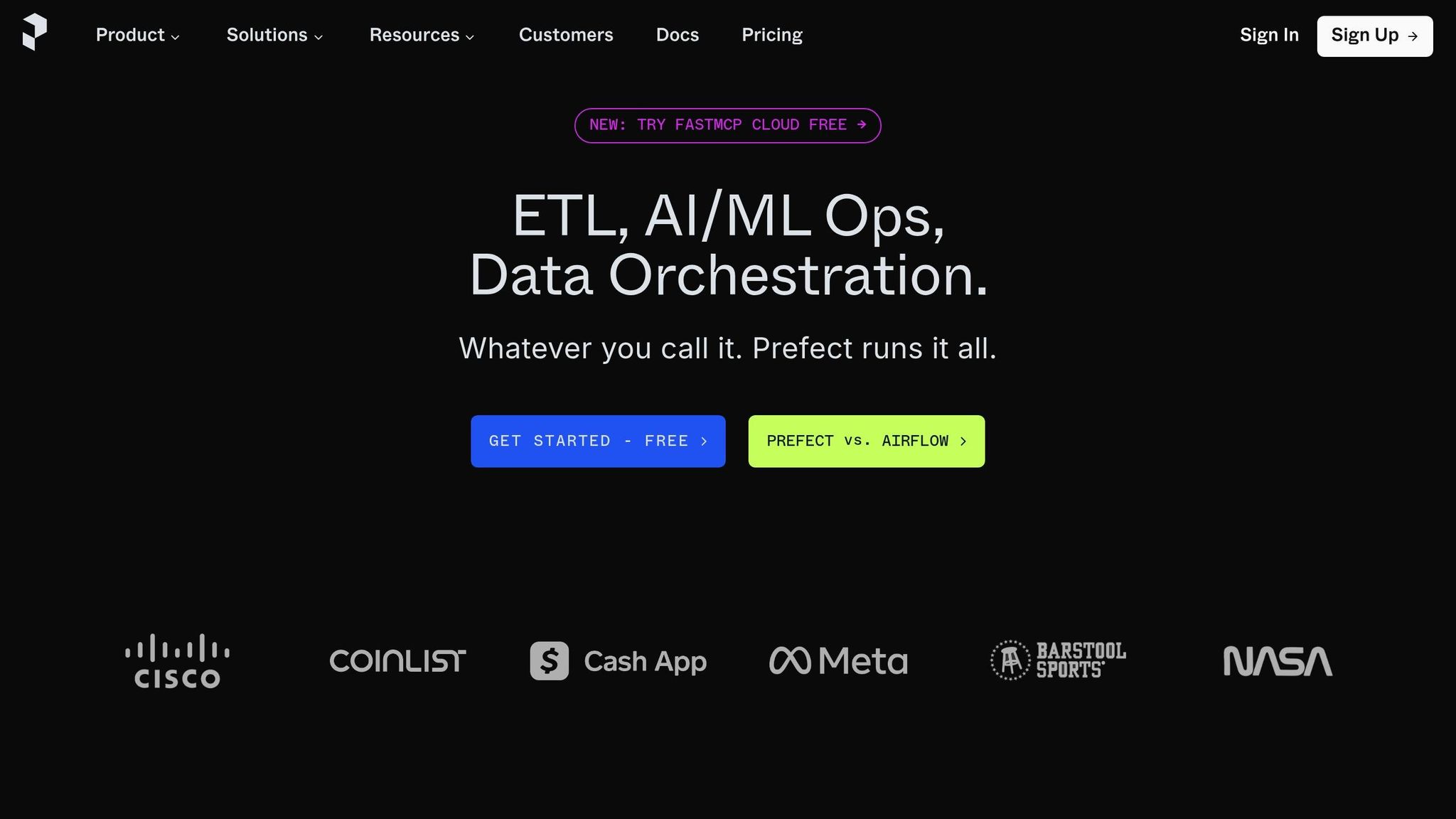
Prefect Orion simplifies the orchestration of machine learning (ML) workflows, catering to teams that prioritize dependable ML automation. With a focus on observability and an intuitive developer experience, the platform makes monitoring and debugging ML workflows more straightforward.
Prefect Orion turns Python functions into orchestrated workflows through its decorator-based system. By applying the @flow and @task decorators, teams can adapt their existing ML code into managed workflows without the need for a full rewrite. Its hybrid design supports seamless transitions between local development and scalable execution environments, ensuring easier testing and debugging. Additionally, built-in retry features and failure-handling mechanisms automatically restart tasks when problems arise. This automation integrates seamlessly with broader orchestration features.
Prefect Orion’s architecture separates workflow logic from execution, enabling independent scaling of compute resources. Workflows can run on platforms like Kubernetes clusters, Docker containers, or cloud-based compute instances. The platform supports parallel task execution across multiple workers and uses work queues to optimize resource allocation. These features allow teams to efficiently manage diverse and demanding ML workloads.
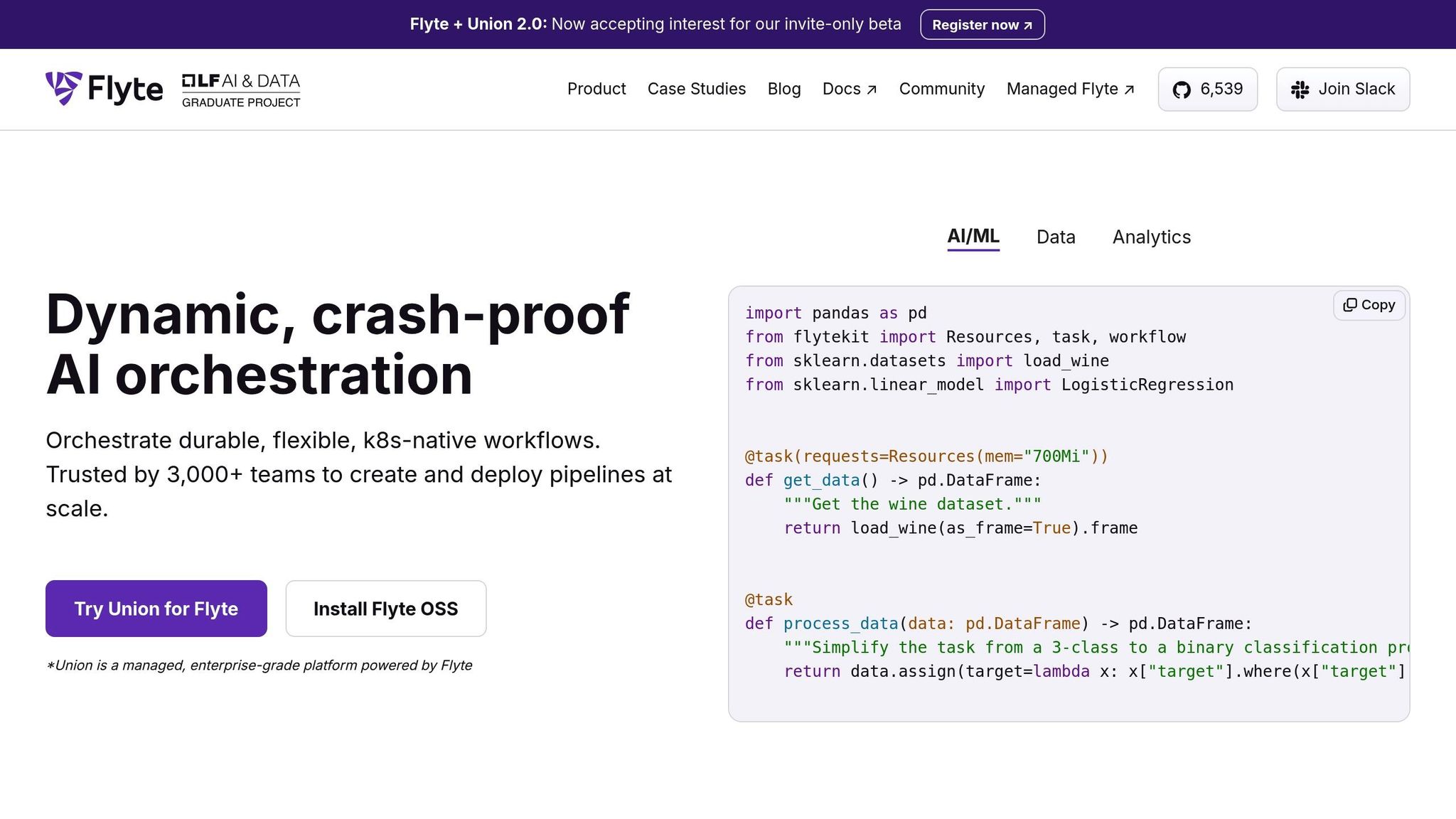
Flyte simplifies machine learning orchestration by turning Python functions into type-safe, decorator-driven workflows. With compile-time validation, errors are caught early, and isolated container execution ensures reliable and consistent results.
Flyte uses a decorator-based approach to transform Python functions into workflows. It automatically tracks data lineage for every execution, making it easier to monitor and audit processes. Teams can define complex task dependencies with a syntax that supports conditional execution, loops, and dynamic task creation based on runtime data.
The platform also offers workflow templating, which allows teams to create parameterized templates. These templates can be reused with different configurations, cutting down on repetitive code and enabling quick experimentation with varying hyperparameters or datasets.
These automation tools work seamlessly with Flyte's scaling capabilities, ensuring efficiency and flexibility in workflow management.
Flyte separates workflow definitions from their execution, enabling horizontal scaling across Kubernetes clusters. This design ensures that workflows are isolated while still allowing teams to share compute resources in a multi-tenant environment.
At the task level, teams can define specific resource requirements, such as CPU, memory, or GPU needs. Flyte dynamically provisions and scales these resources based on workload demands, ensuring optimal performance.
For cost efficiency, Flyte integrates with cloud providers to use spot instances for non-critical batch tasks. If a spot instance is interrupted, its scheduler automatically migrates tasks to on-demand instances, avoiding disruption.
Flyte supports seamless integration with popular frameworks like PyTorch, TensorFlow, scikit-learn, and XGBoost. It also accommodates large-scale tasks using Spark.
For prototyping and experimentation, Flyte integrates with Jupyter Notebooks, allowing notebook cells to be converted into workflow tasks. This feature bridges the gap between development and production.
Additionally, Flyte's REST API makes it easy to connect with external systems and CI/CD pipelines. Teams can programmatically trigger workflows, monitor their progress, and retrieve results using standard HTTP interfaces, enhancing flexibility and operational efficiency.
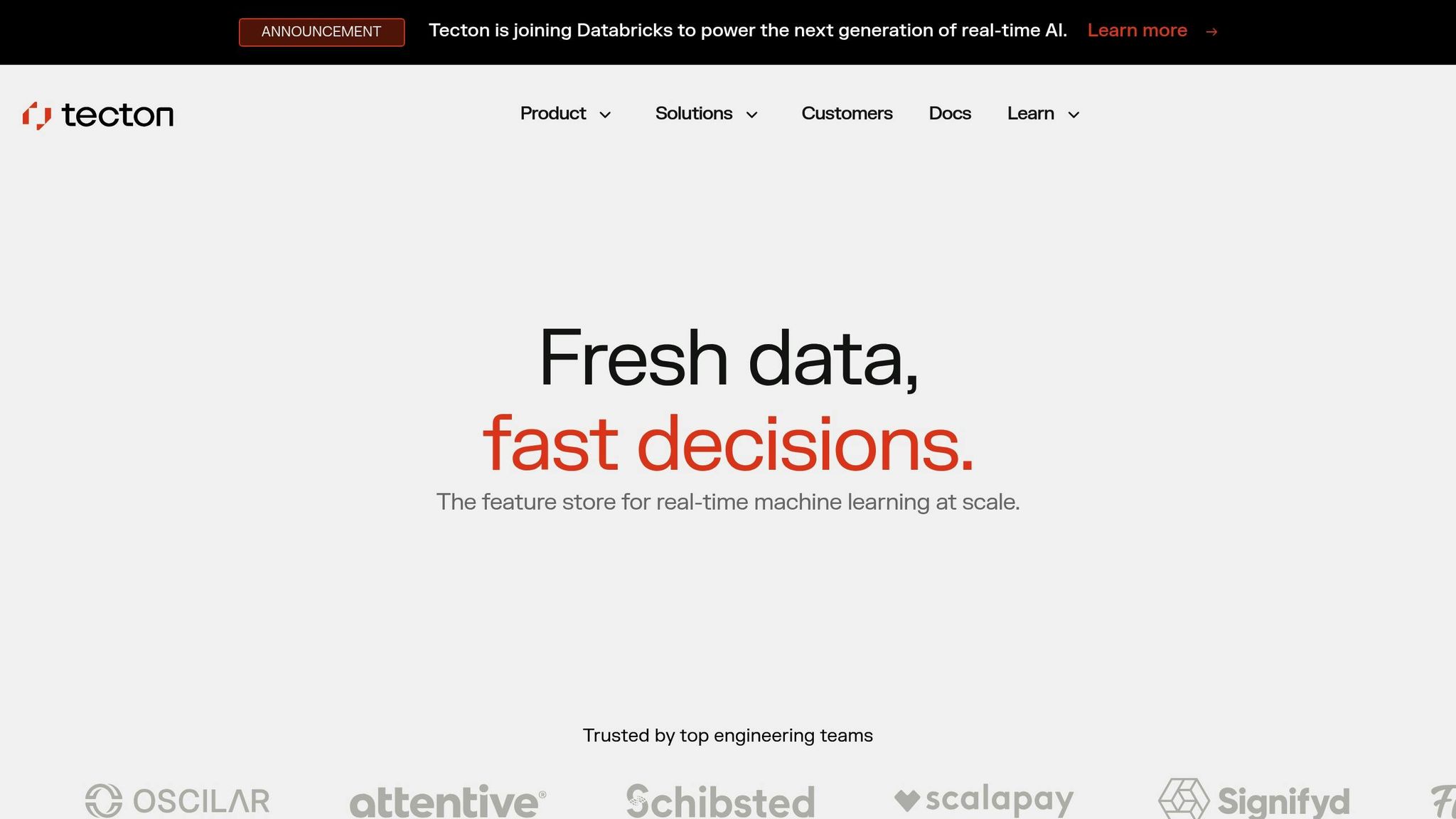
Tecton is a feature store platform that bridges the gap between data engineering and machine learning by reliably serving features for both training and real-time inference. This ensures smoother ML workflows by offering consistent access to features across different environments, complementing other orchestration tools.
Tecton integrates seamlessly with enterprise infrastructure using its Python-based Declarative API. This allows teams to define features using familiar coding patterns while aligning with established code review and CI/CD workflows. The platform also supports unit testing and version control, making it easy to incorporate into existing engineering pipelines.
The platform's flexible data ingestion options accommodate a variety of data architectures. Teams can pull data from batch sources like S3, Glue, Snowflake, and Redshift, or stream data from tools like Kinesis and Kafka. Data can then be pushed via Feature Tables or a low-latency Ingest API.
For orchestration, Tecton offers materialization jobs and a Triggered Materialization API, enabling integration with external tools like Airflow, Dagster, or Prefect for custom scheduling needs.
In July 2025, Tecton announced a partnership with Modelbit to showcase its interoperability in real-world scenarios. This collaboration allows ML teams to build end-to-end pipelines, where Tecton manages dynamic features and Modelbit handles model deployment and inference. A fraud detection example highlights this synergy: Tecton serves features like transaction history and user behavior, while Modelbit deploys the inference pipeline, combining them into a single low-latency API for real-time fraud detection.
Next, let’s explore how Tecton’s architecture scales to handle demanding ML workloads.
Tecton’s architecture is designed to scale, offering a flexible compute framework that supports Python (Ray & Arrow), Spark, and SQL engines. This flexibility allows teams to choose the right tool for their needs, whether it’s simple transformations or more complex feature engineering.
The platform’s latest version incorporates DuckDB and Arrow alongside the existing Spark and Snowflake-based systems. This setup provides fast local development while maintaining the scalability needed for large-scale production deployments.
The impact of Tecton’s scalability is evident in real-world use cases. For instance, Atlassian significantly reduced feature development time. Joshua Hanson, Principal Engineer at Atlassian, shared:
"When we first started building our own feature workflows, it took months - often three months - to get a feature from prototype into production. These days, with Tecton, it's quite viable to build a feature within one day. Tecton has been a game changer for both workflow and efficiency."
This scalability advantage also lays the foundation for Tecton’s ability to automate feature workflows effectively.
Tecton automates the entire feature lifecycle, including materialization, versioning, and lineage tracking, minimizing manual effort and boosting efficiency.
A standout feature is Tecton’s developer workflow experience. Joseph McAllister, Senior Engineer at Coinbase's ML Platform, noted:
"What shines about Tecton is the feature engineering experience - that developer workflow. From the very beginning, when you're onboarding a new data source and building a feature on Tecton, you're working with production data, and that makes it really easy to rapidly iterate."
HelloFresh offers another example of Tecton’s impact. Benjamin Bertincourt, Senior Manager of ML Engineering, described their challenges before adopting Tecton:
"Prior to Tecton, our features were generated independently with individual Spark pipelines. They were not built for sharing, they were often not cataloged, and we lacked the ability to serve features for real-time inference."
Tecton is preparing for the future of AI with its upcoming integration with Databricks. Announced in July 2025, this partnership will embed Tecton’s real-time data serving capabilities directly into Databricks workflows and tooling. By combining Tecton’s feature serving with Databricks’ Agent Bricks, teams will be able to build, deploy, and scale personalized AI agents more efficiently within the Databricks ecosystem.
This integration specifically addresses the need for real-time feature serving in LLM applications, where user-specific and contextual data must be fetched quickly to support personalized AI interactions. It enhances the orchestration of AI workflows, ensuring seamless integration across platforms.
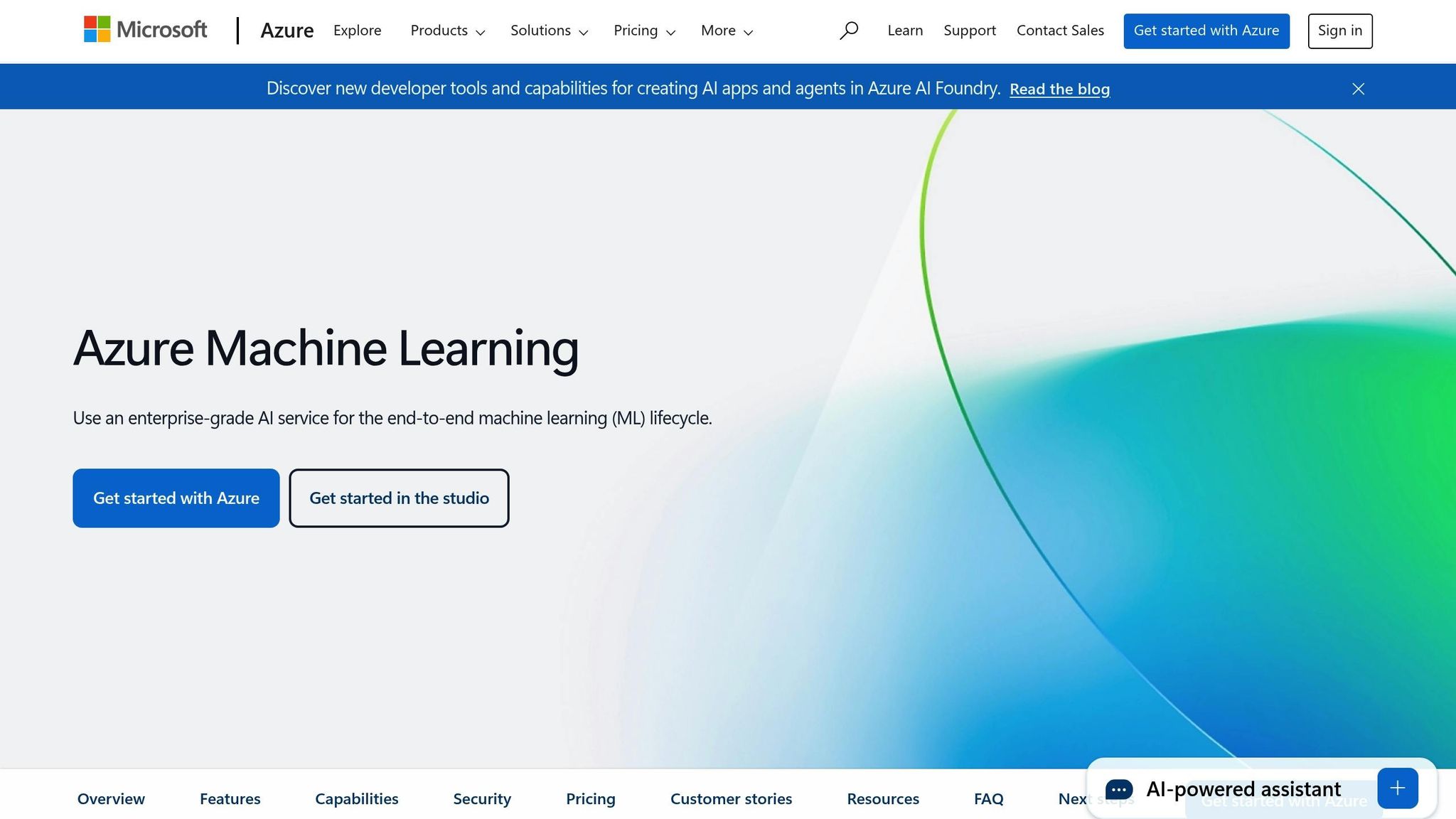
Azure Machine Learning offers a powerful cloud-based platform designed to manage machine learning workflows at an enterprise level. As part of Microsoft's ecosystem, it integrates seamlessly with Azure services while also supporting a wide array of open-source tools and frameworks commonly used by data science teams.
Azure ML stands out for its extensive compatibility with open-source technologies. It supports thousands of Python packages, including popular frameworks like TensorFlow, PyTorch, and scikit-learn, along with R support. The platform simplifies environment setup by providing pre-configured environments and containers optimized for these frameworks. For tracking experiments and managing models, Azure ML integrates with MLflow, offering a cohesive experience. Developers have flexibility in their choice of tools, whether it’s the Python SDK, Jupyter notebooks, R, CLI, or the Azure Machine Learning extension for Visual Studio Code.
When it comes to CI/CD, Azure ML integrates with Azure DevOps and GitHub Actions, enabling efficient MLOps workflows. Additionally, Azure Data Factory can coordinate training and inference pipelines within Azure ML. For large-scale deployments, the platform utilizes Azure Container Registry for managing Docker images and Azure Kubernetes Service (AKS) for containerized deployments. It also supports distributed deep learning through its integration with Horovod.
Azure ML is built to scale effortlessly, from small-scale local projects to enterprise-wide deployments. Its integration with Azure Kubernetes Service (AKS) ensures that ML workloads can grow dynamically based on demand. For edge computing scenarios, Azure ML works with Azure IoT Edge and uses ONNX Runtime to enable optimized inference. As part of Microsoft Fabric, it benefits from a unified analytics platform, which brings together various tools and services tailored for data professionals. This scalability, combined with automation capabilities, allows for efficient management of complex ML workflows.
The platform excels at automating intricate ML workflows. By integrating with Azure Data Factory, it enables the automation of tasks such as training and inference pipelines alongside data processing activities. This automation ensures smooth coordination across data preparation, model training, and deployment stages, reducing manual effort and increasing efficiency.
Azure ML supports large language model (LLM) training with distributed training capabilities via Horovod. It also leverages ONNX Runtime for optimized inference, making it ideal for applications like conversational AI and text processing.
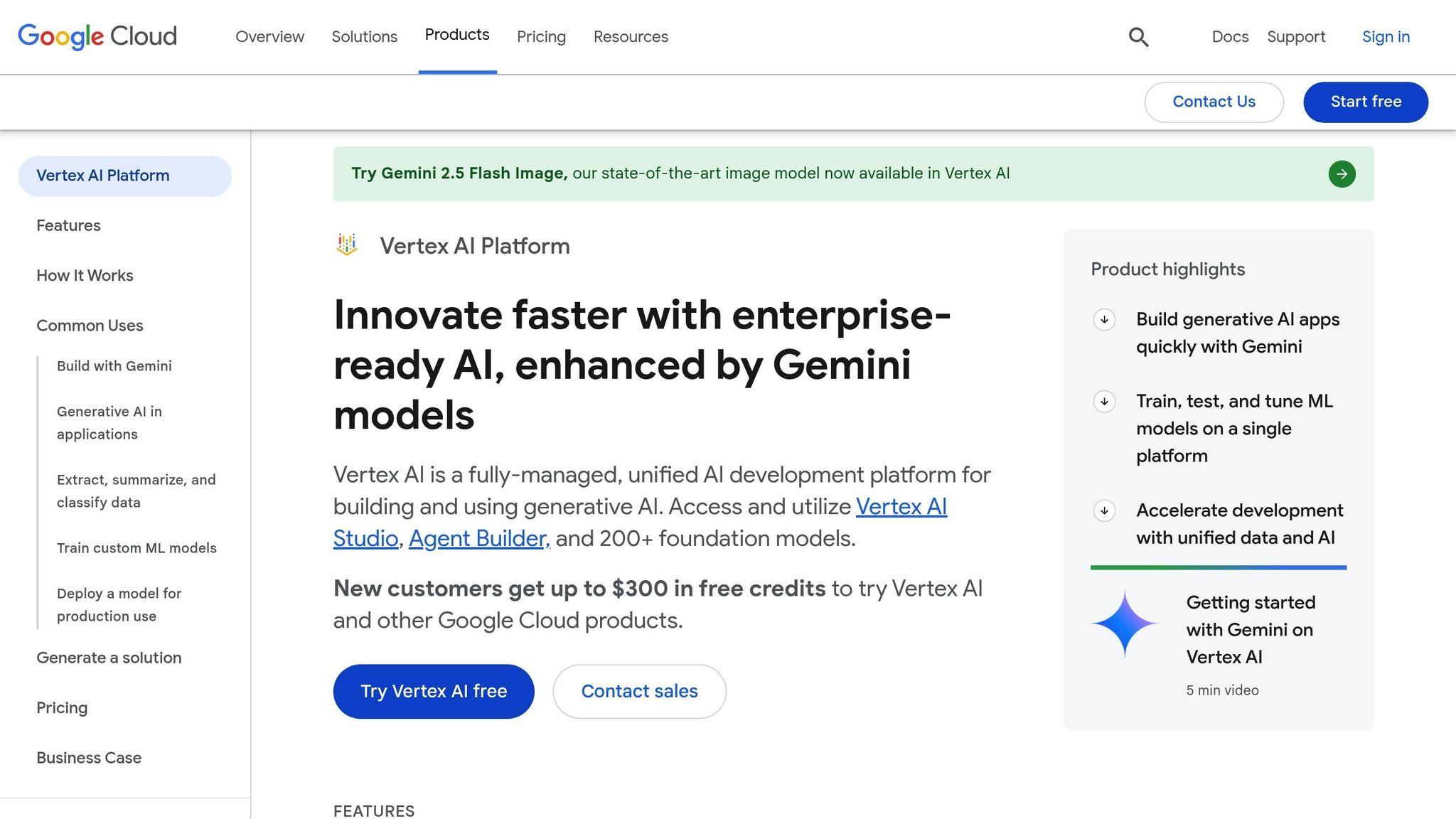
Google Vertex AI Pipelines provides a robust solution for managing machine learning (ML) workflows, combining the power of Kubeflow Pipelines with Google Cloud's advanced infrastructure. It bridges the gap between experimentation and production, offering a seamless experience backed by Google's AI expertise.
Vertex AI Pipelines is built to work effortlessly within the broader ML ecosystem. It supports popular programming languages, including Python, making it easy for teams to stick with familiar tools. Additionally, it integrates with widely-used ML frameworks like TensorFlow, PyTorch, XGBoost, and scikit-learn, ensuring teams can leverage their existing code and expertise without disruption.
The platform’s foundation on Kubeflow Pipelines ensures smooth management of containerized workflows. Teams can package ML components as Docker containers, enabling consistent execution across different environments. For those who prefer notebook-based development, Vertex AI Pipelines integrates seamlessly with Jupyter notebooks and Vertex AI Workbench, offering a familiar environment for experimentation. This cohesive integration creates a scalable and efficient platform for ML development.
Powered by Google Cloud's infrastructure and Google Kubernetes Engine (GKE), Vertex AI Pipelines is designed to handle demanding ML workloads with ease. It supports distributed training across multiple GPUs and TPUs, making it an excellent choice for large-scale deep learning projects. TensorFlow users benefit further from specialized acceleration through Tensor Processing Units (TPUs).
For organizations with variable workload needs, the platform offers preemptible instances to cut costs for fault-tolerant tasks. Its integration with Google Cloud’s global network ensures low-latency access to data and compute resources, regardless of location.
Vertex AI Pipelines simplifies ML workflows through pipeline-as-code functionality. Teams can define workflows in Python using pre-built components, enabling quick and reusable pipeline creation.
The platform also integrates with Vertex AI Feature Store, streamlining feature engineering and serving. This ensures consistency between training and deployment environments, reducing errors and improving efficiency.
Vertex AI Pipelines supports workflows for large language models (LLMs) by connecting with the Vertex AI Model Garden and the PaLM API. This integration allows teams to fine-tune pre-trained language models with their own data while managing the process through automated pipelines. Distributed training for LLMs is supported using TPU infrastructure, employing techniques like model and data parallelism to overcome memory limitations on single devices.
For inference, the platform works with Vertex AI Prediction, which offers auto-scaling endpoints to handle fluctuating request loads. Batch prediction capabilities make it easy to process large text datasets for tasks like sentiment analysis or document classification.
To help teams manage expenses, Vertex AI Pipelines integrates with Google Cloud Cost Management tools. These tools provide detailed insights into ML spending and allow users to set budget alerts, ensuring cost predictability and control.
This section provides a balanced overview of the strengths and challenges of various platforms, helping you make informed decisions based on your organization’s needs. The key takeaways from the detailed platform reviews are summarized here.
Prompts.ai is a standout choice for enterprise-level AI orchestration, offering a unified interface for over 35 leading large language models (LLMs). Its pay-as-you-go TOKN system enables cost savings of up to 98%, while real-time FinOps controls and strong governance address tool sprawl. However, its focus on LLM orchestration may not suit organizations heavily reliant on traditional machine learning (ML) workflows, making it ideal for those prioritizing cost efficiency over broader ML flexibility.
Apache Airflow with ML extensions is widely used for managing ML pipelines, coordinating training jobs, deploying AI models, and handling Retrieval-Augmented Generation (RAG) workflows. Its integrations span GCP, AWS, and Azure ML services, supported by a mature ecosystem and strong community. However, scaling can introduce complexity, and its AI-native capabilities rely on extensions, which may add maintenance overhead.
Domino Data Lab excels in end-to-end management of AI/ML models, tailored for data science teams. Its strengths lie in collaboration and lifecycle management, but these come with high licensing costs and a level of complexity that may overwhelm smaller teams.
DataRobot AI Platform combines automated model training with orchestration, offering tools for governance and bias detection. While it simplifies ML pipelines, its premium pricing and limited flexibility compared to open-source alternatives can be drawbacks.
Prefect Orion is a strong choice for Python-based AI stacks, enabling seamless ML pipeline integration and handling dynamic workflows effectively. However, its smaller ecosystem and lack of enterprise-grade features may make it less appealing to larger organizations.
Flyte is purpose-built for ML and data workflows, offering native support for frameworks like TensorFlow and PyTorch. It handles containerized ML workflows at scale but requires Kubernetes expertise and operates within a still-developing ecosystem, which could be challenging for teams new to container orchestration.
Tecton specializes in real-time ML orchestration and feature operationalization, making it a great fit for feature-focused workflows. However, its narrow focus and higher costs may not suit smaller teams or projects requiring broader workflow capabilities.
Azure ML Orchestration provides a robust suite for enterprise-scale AI orchestration, tightly integrated with the Azure ecosystem, including tools like Data Factory and Synapse. Its advanced features, such as Microsoft AutoGen and SynapseML, support complex distributed AI workflows. The main challenges include vendor lock-in and pricing complexity, which can make cost predictions difficult.
Google Vertex AI Pipelines benefits from Google’s global infrastructure, offering reliable performance and TPU support. However, its dependency on Google Cloud services and potential cost increases with heavy usage may deter some organizations.
The table below highlights the primary strengths and limitations of each platform:
| Platform | Key Advantages | Main Limitations |
|---|---|---|
| Prompts.ai | Unified LLM interface, cost savings (up to 98%), enterprise governance | Limited support for traditional ML workflows |
| Apache Airflow | Mature ecosystem, multi-cloud support, flexible DAGs | Complex at scale, requires ML extensions |
| Domino Data Lab | Comprehensive lifecycle management, collaborative features | High cost, overly complex for small teams |
| DataRobot | AutoML and orchestration, built-in governance tools | Premium pricing, limited flexibility |
| Prefect Orion | Python-friendly, dynamic workflows | Smaller ecosystem, fewer enterprise features |
| Flyte | ML-native, scalable containerized workflows | Requires Kubernetes expertise, maturing ecosystem |
| Tecton | Real-time ML orchestration, feature store integration | Narrow focus, higher cost for small teams |
| Azure ML | Enterprise-scale, Azure ecosystem integration | Vendor lock-in, pricing complexity |
| Vertex AI | Reliable performance, TPU support | Vendor dependency, potential cost escalation |
Selecting the right platform depends on your organization’s priorities, technical expertise, and budget. For cost-conscious teams focused on LLM orchestration, Prompts.ai is a strong contender. If flexibility for traditional ML workflows is essential, Apache Airflow or Flyte may be better options. Enterprise teams already committed to specific cloud ecosystems might lean toward Azure ML or Vertex AI, despite concerns about vendor lock-in.
Technical expertise is another critical factor. Platforms like Flyte require Kubernetes knowledge, while Prefect Orion is more accessible for Python developers. For organizations seeking automation with minimal configuration, DataRobot provides a streamlined solution but limits customization.
Finally, budget considerations play a significant role. Open-source platforms like Apache Airflow offer cost savings but demand more internal resources for setup and maintenance. Commercial solutions, while more feature-rich and supported, come with higher licensing costs. Beyond upfront expenses, consider the total cost of ownership, including training, maintenance, and potential vendor dependencies.
Choosing the right machine learning orchestration platform requires a careful balance of your organization’s needs, resources, and expertise. Here’s a summary of the key takeaways from our in-depth platform reviews.
Prompts.ai stands out for its leadership in LLM orchestration and cost management. With a unified interface supporting over 35 models and its pay-as-you-go TOKN credit system, it offers up to 98% savings while reducing tool sprawl and maintaining strong governance for sensitive applications.
For those seeking broader machine learning workflow flexibility, Apache Airflow with its ML extensions provides a robust multi-cloud ecosystem. However, its complexity when scaling may demand additional resources and expertise.
It’s essential to evaluate the total cost of ownership. While open-source platforms like Apache Airflow have low upfront costs, they require significant internal resources. On the other hand, commercial platforms such as DataRobot and Domino Data Lab deliver extensive features but come with higher price tags. Match the platform to your team’s technical strengths - for example, Flyte is ideal for Kubernetes-savvy teams, Prefect Orion suits Python-centric groups, and automated solutions like DataRobot work well for minimal configuration needs.
For organizations deeply integrated into specific cloud environments, platforms like Azure ML Orchestration and Google Vertex AI Pipelines offer seamless compatibility. However, be mindful of potential vendor lock-in and pricing challenges.
Ultimately, the best platform for your organization depends on your unique priorities - whether it’s cost efficiency, workflow flexibility, enterprise-grade features, or cloud integration. Carefully assess your use cases, team capabilities, and budget to make an informed decision.
When choosing a platform for machine learning orchestration, it’s important to zero in on a few crucial aspects: scalability, user-friendliness, and compatibility with your current tools. A good platform should simplify processes like data preprocessing, model training, deployment, and monitoring, while being flexible enough to match your team’s technical skills.
Equally important is cost clarity - features like real-time expense tracking can make managing AI-related budgets far more efficient. Look for platforms that emphasize security, compliance, and effortless integration of new models, ensuring your workflows remain smooth and adaptable as your requirements grow.
Prompts.ai delivers impressive cost reductions - up to 98% - by bringing together more than 35 large language models into one streamlined platform. This approach removes the hassle and waste associated with juggling multiple tools.
The platform also features an integrated FinOps layer, which continuously monitors and adjusts costs in real time. This ensures businesses get the most value from their investment while maintaining exceptional AI performance.
Open-source platforms like Apache Airflow and Kubeflow offer robust solutions for orchestrating machine learning workflows, but they aren’t without their hurdles. One notable issue is performance - users may encounter slower execution speeds and heightened latency, which can impact overall efficiency. Furthermore, their intricate architectures can introduce dependency bloat, leading to longer build times and additional complexity.
Another challenge lies in integrating these platforms with varied execution environments. This often demands a high level of expertise and considerable effort to ensure compatibility. Efficient resource management can also become a pain point, particularly when scaling workflows or addressing unique computational requirements. While these platforms provide a great deal of flexibility, they might not always be the best fit for every scenario.


